A glimpse into what LEGO Universe could've been
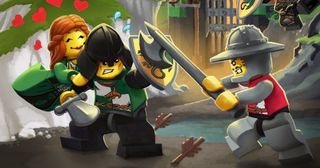
On the eve of LEGO Universe's closure , we sit down with one of the game's concept artists, Mike Rayhawk, who shows off some of the game's gorgeous concept art. Along the way, we ask him questions about the game's development process, what it was like to build, and why he was so excited about where the game was going before it was shut down.
If nothing else, enjoy the awesome LEGO artwork and click any of them to view higher-res versions.
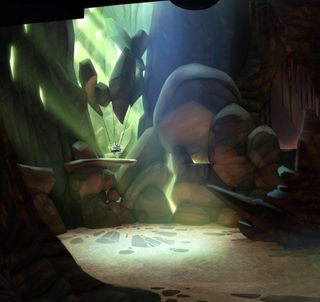
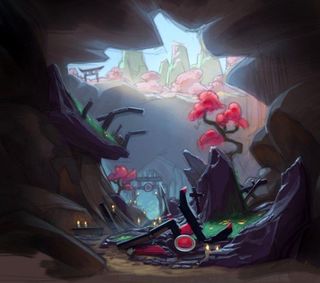
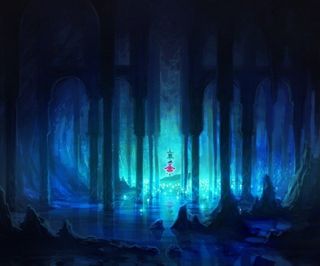
Mike Rayhawk, artist: Ninjago is themed heavily on the five classical elements everyone remembers from childhood: namely, Earth, Fire, Ice, Lightning, and Ninjas. In the caves we really wanted to push Earth's elemental qualities, the same as we were trying to do for Fire in the fire realm images. I was looking at a lot of cathedral interiors and lost temples for reference, trying to capture that sense of gravity and antiquity.
We used an awful lot of caves in previous worlds [before the Ninjago expansion] to divide up the game zones, but they were kept pretty generic—we wanted to keep players' focus on the next set piece or challenge, rather than giving them reasons to hang around in the transitional spaces. Ninjago was the first time the caves themselves got to take center stage.
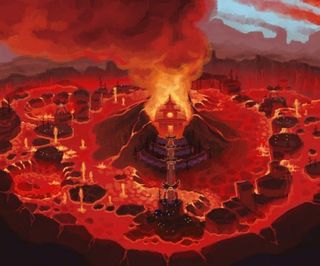
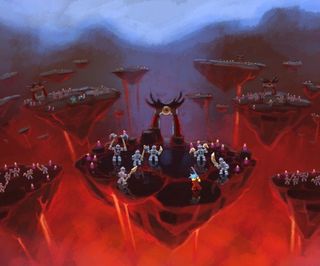
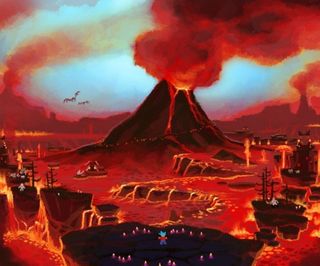
PCG: Was there ever a point in development that you designed something deemed "too scary" or "gruesome" for the game's target audience?
Rayhawk: It's funny you're asking about these images in particular, since these are the toned-down versions. The blue skies were a concession I had to make for the younger audience; originally they were nothing but roiling flame and cinders. At least one version had a god-like Ryan Seabury (our creative director at the time) towering over the horizon and hurling fireballs down from on high, in a similar relationship to what I imagine exists in real life between most toys and their humans.
I was always pushing to make the look of the game more epic and more scary, because I wanted to give some real weight to the struggles of these boxy rainbow-colored plastic figures. In general, I was more successful selling everybody on the epic than on the scary, especially after the kids in the forums started admonishing us for going a little too grimdark with the Nexus Prime update. Nexus Prime and the Spider Boss battle, in particular, I thought were visually scarier than any of the fire realm concepts, with or without a wrathful Seabury looming overhead.
The biggest gaming news, reviews and hardware deals
Keep up to date with the most important stories and the best deals, as picked by the PC Gamer team.
PCG: Was it a nice change to be able to focus entirely on lava and the elements?
Rayhawk: To a degree, but fire worlds have been done to death, and at the time we weren't quite far enough along with ours to figure out anything novel to really set it apart yet.
PCG: If not fire, what's your favorite change that Ninjago's new setting brought to the game?
Rayhawk: All of our content in the first year was organized around a kind of theme-park aesthetic. Especially for the younger players, we wanted to present them with the greatest variety of things to do in the shortest amount of time. As a result, the level designs and quest chains ended up being kind of schizophrenically random in places—you'd have a friendly platforming race, followed by a lethal boss battle, followed by a gift of free topiary and a tutorial on how to rearrange it. The lack of any forward urgency was nice in that it gave kids the freedom to bounce around between all the different areas and activities, but it made it tough to sell the epic "defeat the Maelstrom" feeling.
Ninjago was where I think we turned the corner. We'd built up enough theme-park material to satisfy the younger kids' need for early-game accessibility and breadth of content, and now we could finally dig in and make worlds with longer visual and narrative arcs to satisfy players more in the upper half of the target age group.
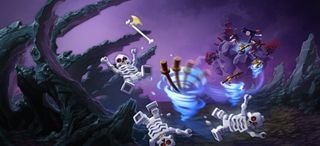
PCG: I love the skeleton's "I just got owned" eyes in this one. What enemies are the most fun to draw in the LEGO universe?
Rayhawk: Dragons. It's not even a contest. Their graphic form allows them to be way more visually expressive than anything else in the game. Just imagine that same scene but with a bunch of dragons making the "I just got owned" face in place of the skeletons, and you'll see what I mean.
That being said, I really enjoyed using any excuse to do drawings of the skeletal-horse samurai. I'd paint up all these awful overwrought monstrosities of flapping rags and swirling ectoplasm that had my team lead tearing his hair out because they were completely unusable.
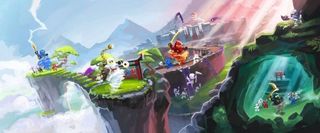
PCG: With four different styles of ninja, which one are you most like and why?
Rayhawk: Normally I identify more with the skeletons, only appearing in the story in order to make the actual heroes look better. But if I had to pick one of the good guys, I definitely take after the fire ninja, who always seems to be doing the opposite of whatever he's supposed to.
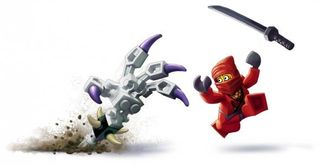
PCG: What inspired this artwork?
Rayhawk: I can't remember if somebody handed me the written concept for the Underhand [enemy type] to draw up, or if I'd just happened to have already built a bunch of skeleton hands at my desk when we decided we needed more Ninjago Skullkin enemies. It's possible that I drew some subconscious inspiration from the graveyard scene in Army of Darkness.
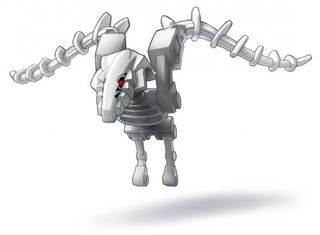
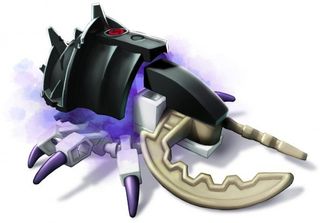
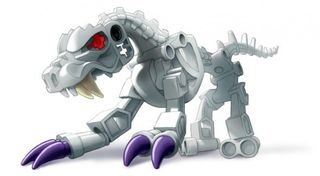
PCG: If you had to estimate, how many creature concepts in total do you think were drawn by the entire team for LU?
Rayhawk: I couldn't even guess. Between the enemy monsters, the friendly animal NPCs, the tameable creatures, the Assembly heroes' summons, the accessory pets that would ride on your shoulder or in your backpack—not to mention all the rideable steeds and the animals you could transform into, coming up in the Castle update—hundreds and hundreds, for sure. And those are just the ones that got approved and made it into the game.
For awhile we had a line of tables in the back of the office that were just covered with the brick-built models for all the creatures in the game. We used to hand them out as schwag; I've got a small menagerie sitting in front of my computer screen even now.
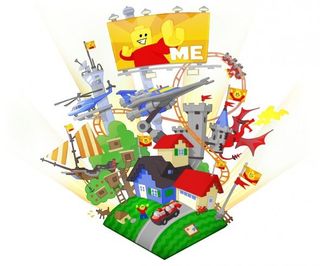
PCG: This looks like a concept design symbolizing the player properties should be about letting players show their personality. Was that your goal with this artwork, and with the player property feature?
Rayhawk: For a big chunk of our target age group, especially for boys, expressing personality takes a far distant back seat to showing off. Property is all about having the coolest stuff and having the most of it, and preferably with lasers mounted on every exposed surface. This picture was part of an effort to get everybody on the dev team to buy into that impulse and really go crazy with it, because we wanted to get everybody pushing the limits of what could be done with properties.
PCG: What's the best thing you ever saw built on a player property?
Rayhawk: I probably didn't explore player properties as much as I should have, but there were a lot of good ones getting passed around the office. There was a multi-level robot factory I was really impressed by—the player had used the in-game Behavior scripting to automate conveyor belts and assembly lines with half-built robots rolling through. There were some other kids who set up their properties with quests that let you take over a spacefighter and take part in dogfights, or to man the cannons and defend a port town from a marauding pirate ship with full barrages and a ship-sinking animation. There was one where the guy had built this massive elaborate model of the capitol building (a convincing rotunda dome is tough to build in LEGO bricks), which became a personal favorite when he went on to add a giant seven-story-tall minifigure attacking it with a chainsaw .
PCG: What's the flat-out craziest thing you saw players build?
Rayhawk: There were a lot of crazy properties full of rainbow-colored mishmashes that towered into the sky, but the one that stands out in my mind was one that was just a hundred-foot-tall toilet monument. What was funny was that it seemed like that place was always packed—at any hour of the day or night there were a dozen minifigures standing around the rim of the bowl engaging in serious giant-toilet appreciation before jumping in.
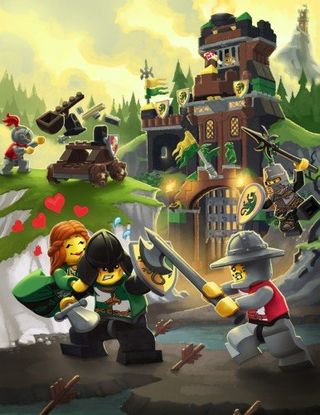
PCG: On your personal site, you list this piece of artwork as "Capture the Princess PvP". Can you go into a bit of detail about how that was supposed to work?
Rayhawk: We always had capture the flag PvP in the internal build of the game, from some of the very earliest pre-beta versions. Besides the usual CTF run-and-gun, a lot of the strategy revolved around managing your minifigure's Imagination supply—do you spend your points defensively to seal up breaches in your own wall, or tactically to construct bouncers and shortcuts that let you outmaneuver the enemy, or offensively on siege weapons to open new holes in his defenses? Do you sacrifice valuable time harvesting mobs for more Imagination, or do you rush straight into battle?
Capture the Princess was just a Castle-themed re-skin of the CTF game we were already playing, except with princesses instead of flags. Because who gets excited about flags?
PCG: That sounds amazing and fairly complex as far as CTF modes go, with siege combat, etc. Was this going to be the best minigame yet?
Rayhawk: It would have been good, but there was some other stuff in the works that I thought was going to be even better. I shouldn't get too specific, in case LEGO is planning on re-using the ideas in some other context, but—speaking of siege combat—we had this castle-vs-castle game in the pipeline, with minifigures on each side running around in a rush to architect new castle sections faster than the other side could build siege engines to destroy them. There was also a new free-roaming race mode on the way that was super fun, with cars tearing back and forth across treacherous terrain in a frantic race of vehicular Maelstrom whack-a-mole.
PCG: Players could race against each other before, but the game rarely pit players directly against each other. Was there concern about forcing players to fight each other?
Rayhawk: This is going to sound weird, but my best understanding is that the obstacle wasn't in letting players fight each other, it was in letting them form teams. LEGO is extremely sensitive about the safety of kids' online interaction, to the point that implementing even the most basic social functions like in-game chat or friends lists became these kind of monumental tragic struggles that swallowed systems designers whole. A lot of our PvP games had to be backburnered while we were waiting for final word about how team functionality would work, or whether we'd be allowed to have it at all.
LEGO's dedication to child safety superseded all concerns of production schedule or profitability, which was a principled move on LEGO's part but it made some seemingly-straightforward parts of development really, really tricky.
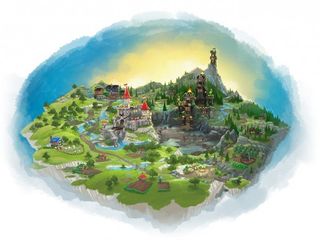
PCG: You tease on your site about how cool the in-development Castle World was, and mention new game modes and features attached to its release. Can you talk about those at all?
Rayhawk: The new ability to form teams and jump into construction-heavy PVP combat modes was definitely the big game-changer, in my mind.
There was plenty of other stuff going on in addition to that. The new steeds and animal transformations [letting players transform into animals] allowed for a very different style of landscape; the ability to cover a lot of ground in a hurry let us make the Castle countryside into a giant sandbox world rather than the linear strings of fairly discrete zones we'd been limiting ourselves to earlier. There were new item-crafting systems ready to go, and there was some talk about giving players the ability to start farms on their properties and harvest resources. So in addition to the really interesting new PVP, there was also a huge delivery of functionality that graduated the game up from kids'-MMO standards to more like what you'd expect from a full-featured MMO.
PCG: How many different themed "worlds" like this did the dev team have kicking around internally for future updates?
Rayhawk: Shifting away from our early eclectic theme-park worlds to the larger epic-driven worlds like Ninjago meant that we had to bring a lot more comprehensive focus to each of the worlds under development. At the end we were limiting ourselves to two new worlds under active development at a time, although there was certainly no lack of further LEGO playthemes waiting in the back catalog.
PCG: What was the one upcoming piece of LEGO Universe that you're most sad will never see the light of day?
Rayhawk: Custom creations in PvP. It's the one thing I was most looking forward to since the day I joined the project, but that we never quite managed to implement. I was really impatient to be able to tune my racecar's performance with different accessories (and eventually, weapons), or to bring different homemade catapults into a castle siege and see which designs were most effective in different situations, or to set loose custom-built autonomous robots to battle enemies or each other.
The racecar tuning, at least, seemed to always be perpetually right around the corner; LEGO already has a pretty good history of racing games that have done this very well.
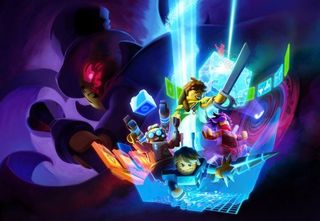
PCG: Is this just a general theme, or for some future content in particular?
Rayhawk: Musing on the game in general was the biggest part of my job description when I first joined the project. I didn't start getting specific deadlines on any regular basis until the game was nearing launch and it was time to ramp up on release-specific marketing.
This painting rose out of general musing like a lot of others, but I was roughly timing it to coincide with the release where players finally got to meet these faction leaders from the game's opening cinematic.
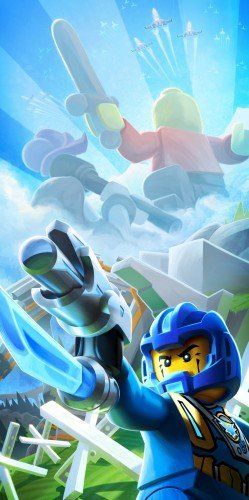
PCG: Is this just a general faction artwork, or for something in particular?
Rayhawk: In early builds of the game environments, we had a lot of random posters slapped all over the walls of buildings. For a while I was exploring the idea of cooking up inspirational Nexus Force recruiting posters, starring some of the factions' secondary heroes.
This picture is of Epsilon Starcracker at his post guarding a pass in the opening section of Avant Gardens, perpetually ready to gun down any Maelstrom enemies who wander too close. We ended up abandoning in-game posters to go with a cleaner bricks-only aesthetic, but I ended up finishing the painting later on anyway, and it ended up being one of my favorite pieces.
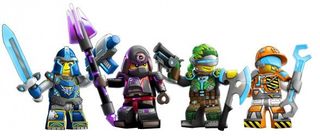
PCG: What was your favorite faction to play as and/or draw?
The Sentinel heroes reliably got the most action-oriented scenes to paint, although I had a soft spot for Doctor Overbuild and his robot arms.
When it came to playing though, I always had the most fun with Paradox characters and their ability to dish out indiscriminate destruction. I imagine each one of them laughing maniacally from the minute they finish brushing their teeth in the morning to the moment they put on their footie pajamas at night.
PCG: Thanks for walking us through your artwork! We have a few general game questions left, if you don't mind. With the game's closure immiment and your 20/20 hindsight, if you could change one thing about the Ninjago expansion, what would it be?
Rayhawk: We had a plan for Ninjago to let players design their own ninja obstacle courses. In the animated movies and physical playsets, the monastery is full of all this deadly spinning training machinery, so we had created a system that gave players a palette of these deathtraps to work with and the ability to arrange them around a monastery hall with different behaviors attached, to challenge and confound any ninjas who happened to wander by.
We had some really interesting series of mechanisms designed. If there was one thing I could have changed about the Ninjago expansion, it would have been to keep the game open for another year so that we could have opened up the make-your-own-deathtrap areas and gotten to see what players built with them.
PCG: What would you change about the game as whole, if you could?
Rayhawk: My job was a lot more about thinking about marketing rather than content, so my changes would all have been to the delivery model. If I could go back in time and dictate release policy, LEGO Universe would have been free-to-play from the start, available by download only, with immediate in-browser character creation to keep players engaged during the download, and supported by microtransactions rather than a last-generation subscription model. Our single most painful obstacle was that it was very, very difficult to explain to non-gamer parents why they had to keep paying money every month for a game that they'd already purchased in physical form.
PCG: Why do you think the game is closing?
Rayhawk: It's funny, because by a lot of objective measures it's been extremely successful: stable service, fantastic public opinion (once we added enough content), a healthy base of free players (over two million, LEGO just publicized), and a growing base of paying players who were dedicated and deeply invested in the game. We had a seasoned and motivated dev team, and a parent company with the financial stability to ride out those first couple of years that every MMO needs to gain traction and reach profitability. From a product standpoint, we in a great position, and lots of companies would have killed for our numbers. In the right hands, LEGO Universe was (and still would be) an absolute gold mine waiting to be tapped.
But in the wrong hands, it's a liability, threatening to damage the core LEGO brand as soon as a tone-deaf decision by management outrages the userbase, or if there were even the barest rumor of a child safety breach, or in any of the million unpredictable situations where an online community can suddenly turn itself against you without warning.
Everybody on the team has their private conspiracy theories about the real reason LEGO shut down the project right as it was getting its legs under it. I think LEGO management took a sober assessment of their own unfamiliarity with exactly what MMOs are and how they work, and realized that they couldn't trust themselves not to steer the ship straight into the rocks.
PCG: Could anything have been done to save it? Is it too late to hope for a revival in the future?
Rayhawk: LEGO's priority on child safety, and the competing scales of the numbers involved, make me think it'll be tough to make the business case. It's always hard to balance pouring resources and attention into a side project with a potential to make millions of dollars, when it means pulling resources and attention away from a core business that measures its revenue in billions.
Judged solely on its own merits, LEGO Universe was a fantastic project that I'll always be proud to have been a part of. Viewed in the larger context of LEGO's overall portfolio, I can't escape the mathematical inevitability of the decision to close it down. Weighing the potential profits of the product against the potential costs to the brand, I privately suspect that a kids' MMO may just always be too risky for a company with so much brand equity invested in an uncompromising reputation for child safety.
On the other hand, I also don't think it's likely that LEGO is going to stop looking for new ways to bring the LEGO experience online; the digital platform is too important not to continue making it a priority. In that regard, I expect that the experience gained across the company will end up being crucial to the development of new online projects moving forward, even if LEGO Universe didn't reach commercial success in its own right. Taking the broken pieces of earlier models and building them into something new, after all, is what LEGO is all about.
PCG: So after the game closes tonight at midnight EST, what will you work on?
Rayhawk: There's always lots of regular LEGO work to be done outside of LEGO Universe, so I've been picking up illustration jobs here and there from other departments while waiting for the 2012 product cycle to gather steam. In a week or two, I'll be off to take a new position back at LEGO's U.S. headquarters and rejoin the mothership, where I'm looking forward to getting back into the groove of illustrating physical products again rather than virtual ones.
Most Popular






